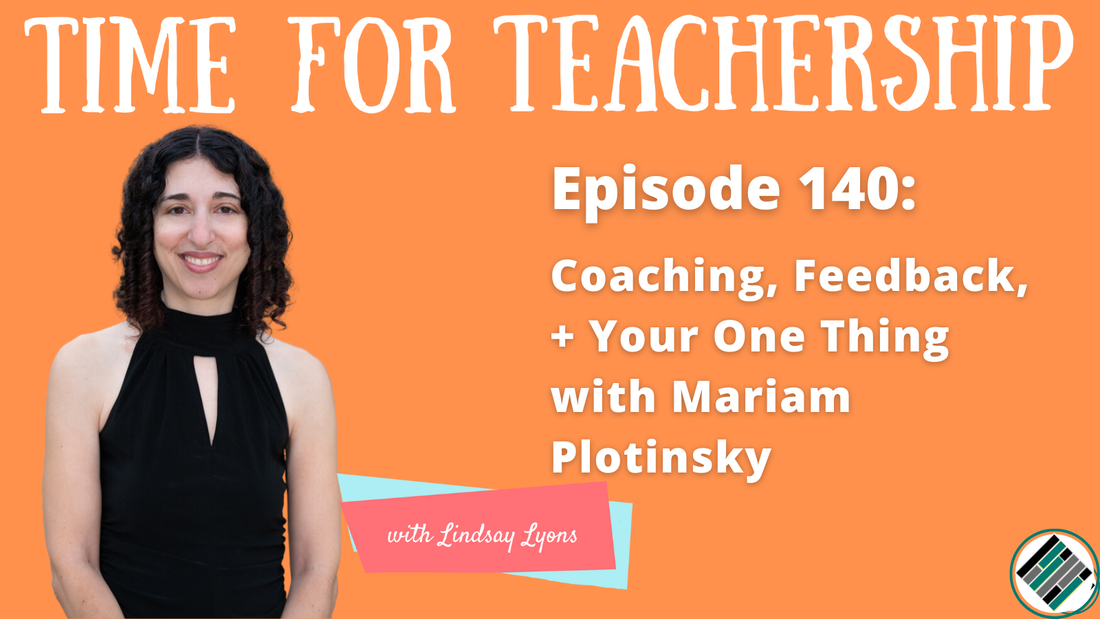
Listen to the episode by clicking the link to your preferred podcast platform below:
In this podcast episode, Miriam Plotinsky discusses the essence of leadership in education. including the importance of humility and openness to change, and how to create effective teacher coaching programs that focus on simplicity and collaborative communication. She also discusses shared leadership and overcoming resistance, highlighting the importance of teacher and student voices in decision-making processes and providing strategies to navigate any resistance that may arise.
Miriam Plotinsky is an author and instructional specialist who addresses challenges in both teaching and leading across schools with a wide range of differentiated needs. A strong advocate for student-centered learning, she provides coaching and professional development for teachers and administrators. In this episode, we talk about curriculum, professional development, teacher coaching programs, and the importance of humility in leadership. The Big Dream Having a clear vision of where we're going—what we are teaching and why—and to communicate it effectively to students. Alignment to the 4 Stages: Mindset, Pedagogy, Assessment, and Content Mindset is like an umbrella, overarching all other aspects of teaching. Mariam stresses the importance of building a growth mindset, being open to different perspectives, and being willing to admit when we are wrong as leaders. Pedagogy, assessment, and content, she says, fall into place when teachers have a clear understanding of what and why they are teaching. Mindset Shifts Required Clarifying what and why you’re teaching prevents a lot of “classroom management” problems. Mariam says, “New teachers will say ‘I'm so worried about classroom management.’ But they don't mean that. They mean ‘I'm worried, I won't be able to control my class.’ And so one thing I've been trying to make a connection between is if your instruction is where it should be, you won't have as much to worry about.” Action Steps What can leaders do? Step 1: Start with identifying (and helping teachers to identify) what we are teaching and why. This clarity helps align all other aspects of the teaching process. Step 2: Implement effective teacher coaching programs. Harness the human resources within the building, let each teacher be a leader, and set up structures where they can help each other. Step 3: Adopt shared leadership. This involves including teacher and student voices in decision-making processes and avoiding the pitfall of surrounding ourselves with “Yes” people. Challenges? One of the hardest things is giving people the help they actually want. Mariam suggests getting “feedback on feedback.” One Step to Get Started Decide on your one thing, and stay focused on it. Stay Connected You can find Mariam on Twitter: @MirPloMCPS, Facebook: Miriam Plotinsky (author page), or her website. To help you get even deeper into the concepts Mariam discussed in this episode, she’s sharing this link to her articles published in Edutopia. And, if you’re looking for more details on the ideas in this blog post, listen to episode 140 of the Time for Teachership podcast. If you’re unable to listen or you prefer to read the full episode, you can find the transcript here. Quotes:
If you enjoyed this episode, check out my YouTube channel where I show you a sample unit arc on the topic of safety and freedom:
0 Comments
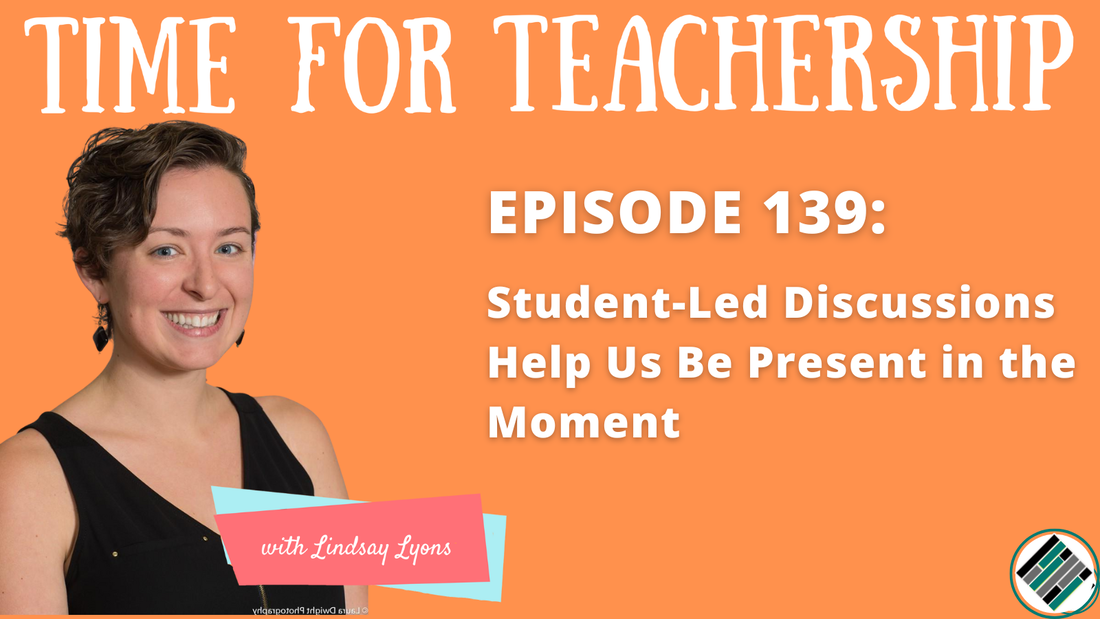
Listen to the episode by clicking the link to your preferred podcast platform below:
The spark for this episode comes from my just-for-fun reading life. I was reading (actually listening to the amazing Lauren Graham) One Italian Summer by Rebecca Serle. In Chapter 3, Serle describes the main character traveling for the first time on her own like this: "I am somewhere new where I have to be nimble, alert, present. It forces me into the moment in a way I hadn’t been in a year, maybe even ever.”
This connected with me because I want to be more present in the moments of my life. It also made me think about my experiences in the classroom when my students led discussions. This type of lesson "forces me into the moment.” When students run the show and can take the conversation in 100 directions that I have to be ready for, it requires me to be "nimble, alert, present." Why? I don’t think I’m alone. Many teachers—many humans—likely want to be more present in the day-to-day moments of our lives. Educators also have a ton of things to constantly be doing or thinking about doing, which takes us out of the moment. Certainly, there are many structural supports we need to put in place to improve teacher working conditions, including taking tasks off teachers’ plates. At the same time, I’d love to see leaders helping teachers to co-create the class conditions and design lessons for thoughtful student-led discussion. In my experience, this creates moments of professional satisfaction (seeing my students be brilliant without me stepping in is an absolute joy) and one of the more immersive types of experiences I’ve had as an educator (you know those ‘Oh wow, class is over?!’ moments). Leaders (Coaches, Department Chairs, PD Facilitators) Can… Step 1: Ask teachers to identify when they feel most present during class. Invite teachers to share, brainstorm, and plan how to create more feelings of being fully present with students. Offer any supports that may help (e.g., professional learning resources, opportunities to start meetings with a moment to reflect on moments of being present). Step 2: Offer Professional Development sessions on student-led discussion. Set teachers up for success by helping them plan out:
Step 3: Support teachers new to student-led discussions to try it out. Decrease the pressure. Trying new pedagogical strategies can be scary, especially strategies that require teachers to step back and respond to student ideas versus adhere to a structured information-sharing type of lesson plan. Co-create a list of evidence of success with your teachers. This way, you can emphasize the focus on student comments and actions instead of teacher actions. Step 4: Encourage visits to peer classrooms. Invite teachers who frequently have rich, student-led discussions to share what they do well. Ask if anyone would be interested in having teachers new to student discussions visit their class to see one in action. If yes, you can share a Google Doc/Sheet where teachers can add dates and times when they are having a class discussion. Offer coverages for visiting teachers as needed. Step 5: Facilitate ongoing reflection. Regularly invite teachers to share successes such as insightful student comments and practices or discussion questions that have generated high student engagement. Final Tip I’m inspired by Shane Safir and Jamila Dugan’s concept of a pedagogy of student voice, which they write about in their book, Street Data. In it, they encourage teachers to design lessons that have students talking 75% of the class time. Since publication, I’ve heard Shane Safir say the percentage maybe should have been even higher. I think this is a great goal to guide our aspirational teaching, coaching, and leading. To help you help teachers implement more student-led discussions in your school or district, I’m sharing my Circle Facilitation Guide with you for free. (This is my all-time favorite student-led discussion protocol!) And, if you’re looking for more details on the ideas in this blog post, listen to episode 139 of the Time for Teachership podcast. If you’re unable to listen or you prefer to read the full episode, you can find the transcript here.
If you enjoyed this episode, check out my YouTube channel where I explain the difference between build a base and case studies:
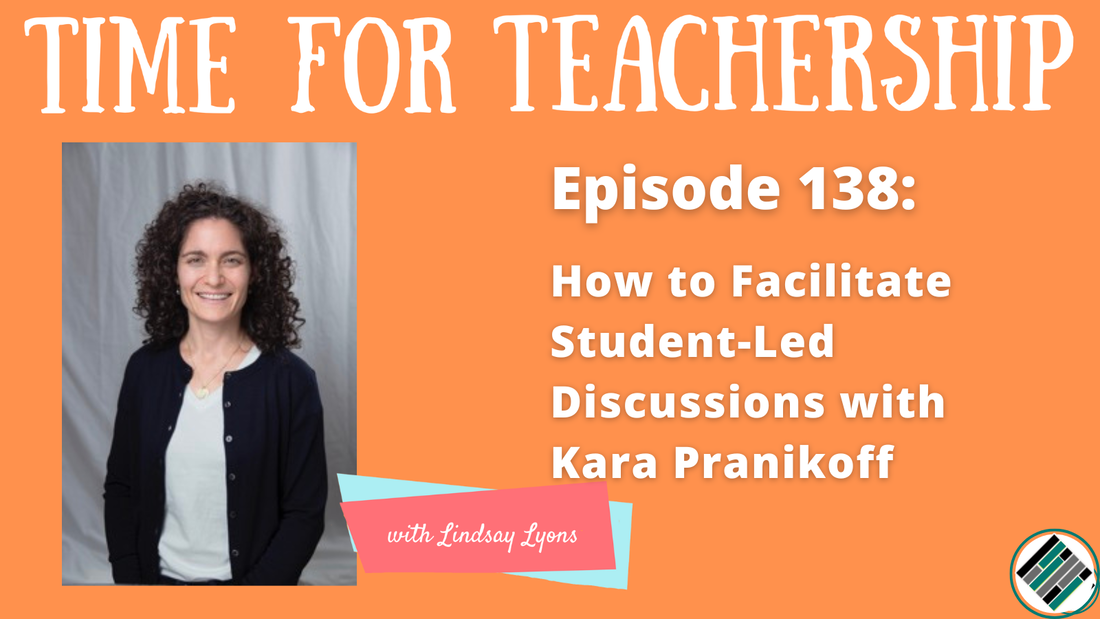
Listen to the episode by clicking the link to your preferred podcast platform below:
In this podcast episode, we delve into the power of meaningful conversations in education, emphasizing the role of educators in fostering student voices, creating safe spaces for student expression, and setting monumental goals for academic growth. Kara presents tons of useful student-led discussion strategies, and of course, we tackle the challenges of teaching students to engage in discussions about issues of justice and equity.
Kara Pranikoff is an educator in New York City. She has worked as a classroom teacher; reading interventionist; Instructional Coach; curriculum designer; and an adjunct instructor at Bank Street College of Education. As a consultant Kara partners with school to nurture independent thinking, voice and a sense of belonging for all members of the community. She supports educators in deepening their practice of inquiry-based teaching of social studies and writing. Kara’s book, Teaching Talk: A Practical Guide to Fostering Student Thinking and Conversation (Heinemann, 2017) shares ways to foster productive and independent student discussions in elementary and middle school classrooms. The Big Dream Kara’s dream for educators is to keep their eye on the big picture of education. We are raising humans! As educators, we walk alongside children on their journey of growth. Alignment to the 4 Stages: Mindset, Pedagogy, Assessment, and Content Educators who can adopt an abundance mindset and understand that nurturing student voices is a process are going to be highly effective. For pedagogy, we want to co-create an environment of understanding between teachers and students, set community agreements, and provide time for conversation and reflection. For assessment, we can create an artifact of student-led conversations and of course, have clear expectations for what teachers and students should ideally be doing in a student-led discussion. As far as content, discussion should revolve around topics relevant to students and their life experiences. Mindset Shifts Required We have the time and resources for what is truly important. We can remind ourselves (and our teachers) that nurturing student voices is a process that requires patience and deep listening. Action Steps Step 1: Be clear and explicit with your students about the fact that you are working to ensure their ideas are central is really important. Step 2: Set community agreements about what talking and listening (i.e., a good discussion) is going to look like and feel like in the community. Step 3: Invite students to share some ideas they want to talk about—maybe based on a text that you just read. Then, students can vote on what they want to talk about. Go with it! Step 4: After a discussion, provide dedicated time for reflection and student autonomy to problem-solve and explore how they experienced the discussion and what they might want to change moving forward. Step 5 (ongoing): Curate sparks! (e.g., images, topics, quotes, song lyrics that might generate student conversation) Challenges? Overcoming the fear of saying the wrong thing during difficult conversations and navigating conversations about justice and equity. Action steps for this challenge:
Teachers may also feel pressure to keep conversations on track and avoid tangents. Action steps for this challenge:
One Step to Get Started Find a friend or a coach to help navigate the process. This person can provide support and help with preparing responses to difficult conversations. Also, communicate with parents and caretakers from the get-go about the pedagogical approach and the importance of open conversations in the classroom. Stay Connected You can find Kara on her website: www.eyesopeneducation.com. To help you implement the ideas in this episode, Kara is sharing her Partner Talk Data Collection Resource with you for free. And, if you’re looking for more details on the ideas in this blog post, listen to episode 138 of the Time for Teachership podcast. If you’re unable to listen or you prefer to read the full episode, you can find the transcript here. Quotes:
If you enjoyed this episode, check out my YouTube channel where I show you how to turn worksheets, lesson plans, etc into templates:
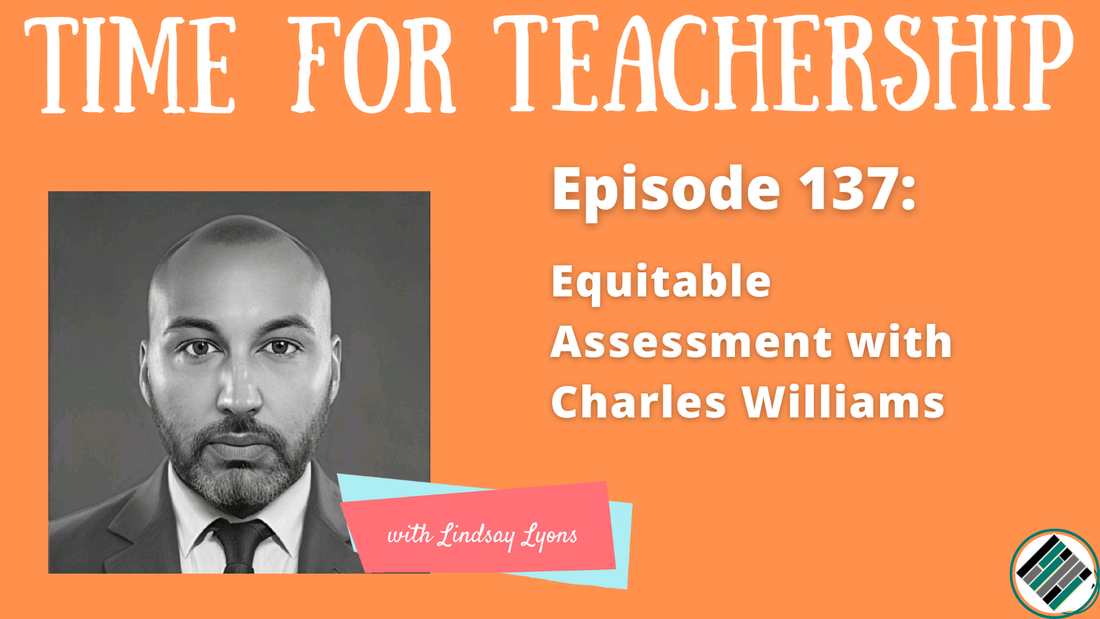
Listen to the episode by clicking the link to your preferred podcast platform below:
In this podcast episode, Charles Williams dives into a comprehensive discussion on rethinking education. We explore the importance of equitable assessments in classrooms and critique the traditional approach to grading and feedback. Charles emphasizes the significance of providing feedback that doesn't contribute to the overall grade, promoting a safe learning environment free from the fear of failure.
Charles Williams has served as an educator for nearly 20 years as a teacher, an assistant principal, and a principal for students in grades K-12. He also serves as an equity advocate with the Equity Offices of the City of Chicago and the Chicago Public Schools. In this episode we explore the power of equitable assessments, honest feedback, and challenging traditional grading systems. And we keep it “sugar free.” The Big Dream Open-mindedness (not having sugar-coated conversations) and understanding the purpose of grading and assessments and feedback. Specifically, grading is equitable and feedback is continuous, authentic, and meaningful. Alignment to the 4 Stages: Mindset, Pedagogy, Assessment, and Content Charles emphasizes the need for an open-mindedness in the teaching community, a shift away from averaging grades, and a focus on ungraded formative assessments. He offers this metaphor: “I think about sports. When I go out and I practice, there's no points for that. I'm not getting any stats right…For football, for example…That happens Friday night. You know, nothing else counts. The tackles I had during practice, the yardage that I ran, the touchdowns that I threw. None of that matters Monday through Thursday. Until Friday night, and those lights come on. Now it counts. So why do we struggle so much with it when it comes to academics? It's that same concept. When it's game time, now it counts.” The content, he believes, should be driven by the students' learning journey, not by an overall grade. Each student can have, in essence, their own IEP. He explains, “there's no one way…but I think it's stepping back and looking at: What do my students need and what is a practical way for me to develop or introduce that, to provide that? You know it's not the convenient thing, right, but it's also on the other end…not just saying..I'm gonna create a lesson for every single student. That's not feasible. But falling in that middle is what do they need and what can I actually provide? And in recognizing that, sometimes I gotta take my hands off and let them go, which, again, as I said earlier, I think is a scary thing for a lot of educators.” Mindset Shifts Required We can question the convenience of traditional grading systems, see beyond the transactional experience of grades, and help students embrace a learning journey that is not motivated by fear of failure. Action Steps What could it look like to start building the foundation for a shift to equitable grading in your school or district? Step 1: Start by reading Grading for Equity, a book that provides a comprehensive understanding of equitable grading systems. Charles says it’s crucial to read it in its entirety to grasp the complete concept and its implementation. Step 2: After gaining insight from the book, initiate conversations within your teaching community about these concepts. Understand the potential obstacles and discuss how to overcome them. Step 3: Test out these concepts in an elective class or subject. Learn from the implementation, make necessary adjustments, and then scale it up to core subjects. Challenges? Challenge: The non-zero policy. Response: ask: Is it actually equitable? Are we setting up students with unrealistic expectations? Charles explains, “You're receiving half credit for doing nothing…and…learning how to game that system, because that's essentially what we're teaching students: How do I game the system so I can do as little as possible and get a grade? Because, again, we're still in this transactional experience…Instead of focusing on that mindset shift of ‘Why am I in school?’ and shifting that over to the process of learning as opposed to that transactional experience.” Challenge: Stopping short of the depth of the concept (e.g., thinking equitable grading will help Black and Brown students at the expense of white students). Response: “That's not the whole concept…It's about understanding that sometimes students don't have resources or the supports at home that other students have…but again…If we're not averaging it, it doesn't matter, because all that homework should do is provide an opportunity to learn and to practice a skill.” One Step to Get Started Familiarize yourself with the concept of equitable grading systems. Reading Grading for Equity is a great way to start. As often as you can, step back and ask; “Why are we doing this? Does it make sense? Is is it what's best for students?” Stay Connected You can find Charles on his website and on Twitter @_cwconsulting. I also recommend his podcast, The Counter Narrative Podcast. To help you implement some of the ideas Charles shared, I’m sharing my Diagnosing Adaptive Challenges Mini Workbook with you for free. And, if you’re looking for more details on the ideas in this blog post, listen to episode 137 of the Time for Teachership podcast. If you’re unable to listen or you prefer to read the full episode, you can find the transcript here. Quotes:
If you enjoyed this episode, check out my YouTube channel where I show you how to use post-it planning and digital adaptations for success:
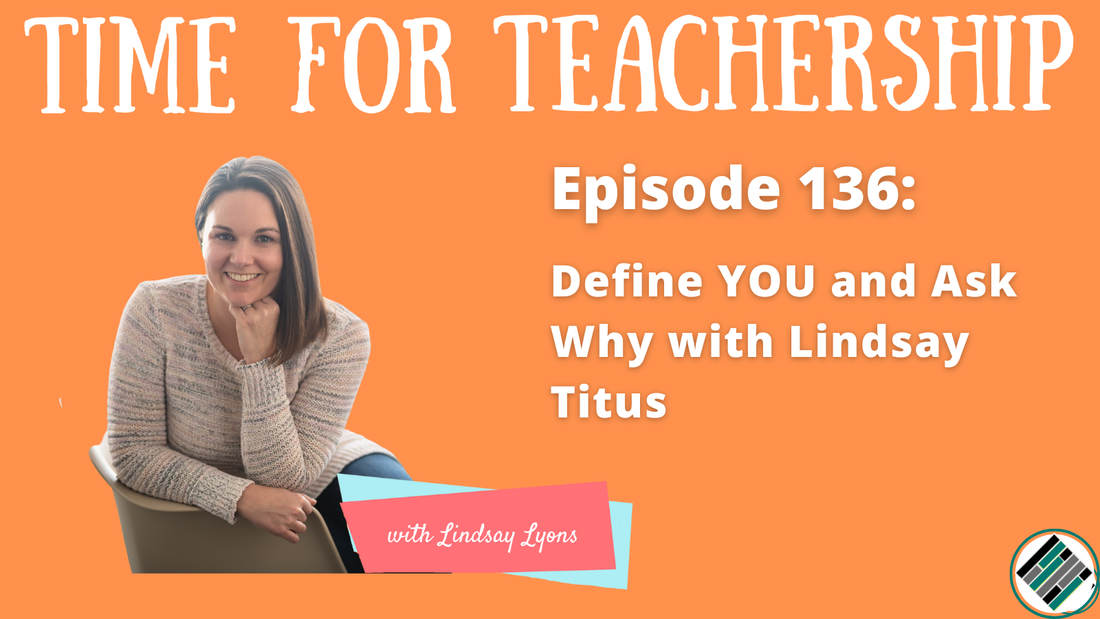
Listen to the episode by clicking the link to your preferred podcast platform below:
Lindsay and I explore the significant impact of connecting with students on a personal level, engaging in empowering conversations, and making education relevant to their lives. We also delve into the role mindset plays in creating a thriving educational environment. Join us as Lindsay Titus shares tips on how to incorporate this approach in our everyday interactions with young people, and discuss how to empower students (and ourselves) through self-reflection and action.
Lindsay Titus has been in the field of education for 17 years and specializes in the study of behavior analysis. She is passionate about helping educators create a mindset that allows them to live a life of purpose and passion inside and outside of the school setting! In this episode, we talk about getting to be humans first, defining who we are, and the power of asking why…all in service of creating curricula and pedagogy that honors the humanity of students and makes class relevant to who they are right now. The Big Dream To create a thriving educational environment where students are treated as people first, and curriculum and instruction are connected to who students are now, not who we think they should be or will be or could be. Alignment to the 4 Stages: Mindset, Pedagogy, Assessment, and Content Mindset is the foundation for creating a thriving educational environment. Aligning our beliefs with our actions will better support students and foster meaningful connections in the classroom. “We often use the house analogy…I can bring in the greatest windows and doors and paint and things like that. So I can have really good assessments that are actually helping us move the needle forward…I can be teaching content that is relevant to now, but if I don't have the belief or the mindset that this is important…there's a disconnect, and so I truly believe that [mindset] has to be the foundation.” “That's really what I help educators do. It's like here's the situation we have. Let's unpack it and we're going to go deep…to figure out what's the barrier. And then, how do we…create new habits, new standards, new boundaries, new values, so that this now just becomes our new foundation?” Mindset Shifts Required Educators need to understand that they have the power to create change within themselves. Many say “if my leader changes, if my admin changes, if my school policy changes, if I change schools, if something else changes, then I'll change.” That’s what Lindsay Titus calls “the chase.” Chasing a dream or chasing a change isn’t the fix because we keep experiencing the same things. We are never doing anything new. We're building on from experience that we have, and that doesn't mean we have to keep doing what we've always done. Draw Your Ideal Self Triangle Step 1: Draw your ideal self triangle. On a perfect day, how will you show up? At one point of the triangle, write or draw what you look like. At another point, what you sound like. At the final point, what you feel like. Step 2: Then, on a day where you're not finding the joy, refer to this “anchor document.” Notice things like “my ideal self speaks gratitude, not complaints,” and try to find gratitude. Step 3: Repeat this ideal self triangle description/drawing every 4-6 months. Two Steps to Get Started Start with gratitude - Set aside three minutes each day to focus on things you are grateful for. Connect gratitude to something you see all the time, like mirrors. Every time you pass by a mirror, remind yourself of something you are grateful for. Ask: What is one thing I can do today? What is one step, one small, simple step I can take to build that momentum? Stay Connected You can find this week’s guest on her website, DefineYOUniversity.com. She’s also on Facebook and Instagram. To help you define your ideal self, deeply reflect, and practice gratitude, Lindsay is sharing her 7-Day Journal with you for free. And, if you’re looking for more details on the ideas in this blog post, listen to episode 136 of the Time for Teachership podcast. If you’re unable to listen or you prefer to read the full episode, you can find the transcript here. Quotes:
If you enjoyed this episode, check out my YouTube channel where I help educators implement new project ideas:
Listen to the episode by clicking the link to your preferred podcast platform below:
In this episode, Nadia A. Bennett talks about the pressing need for anti-racist school environments, her dream for curricula that equips students to grapple with social issues head on, and a concrete example of a school in which the leader said racism was too hard to solve. (She insightfully shares how she responded in that last situation.) We go deep into the journey of leading anti-racist work including the challenges along the way and practical strategies for what your anti-racist leadership can look like.
Nadia Bennett is the founder of When Brown Girls Lead™, an education consulting firm that leads the way for schools to become anti-racist learning environments through culturally-relevant leadership development and mentorship. For more than 15 years, Nadia served in education, as teacher, principal and executive director of K-12 schools. In this episode we go deep into the journey towards leading anti-racist work including the challenges along the way and practical strategies for what your anti-racist leadership can look like. The Big Dream Nadia says, "The curriculum that is used in schools would lead students to this truth that the mind is a weapon and reading is one of the best ways to sharpen that weapon." She envisions a curriculum that equips students to grapple head-on with social issues like poverty and racism. Alignment to the 4 Stages: Mindset, Pedagogy, Assessment, and Content Mindset is really important. Nadia says, "We have to embrace unlearning, the lies that we have been told," she emphasizes, adding that anti-racist schools begin with anti-racist adults. “Shift, unlearn, learn the truth, make a decision to move forward in a space of anti-racism, equity, equality,” she says. Mindset Shifts Required Nadia stressed the need for adults to take responsibility for creating anti-racist school environments. "The adults have to do the work because the adults are making the decisions, setting the policies, and creating the systems and structures," Nadia explained. Action Steps In our conversation, Nadia outlined three key steps to confronting racism in schools: Step 1: Look at the data. According to Nadia, the data can reveal disparities in education that often slip beneath the radar. "One of the best things you can do is show them the data.” Step 2: Assess why the disparities exist. "We need to assess why there are so few Black and Brown children in AP and honors," Nadia states, urging educators to take a hard look at the adult actions leading to these student outcomes. Step 3: Adults must take responsibility. Nadia stressed that adults have to have the courage to do this and commit to making changes. Challenges? Nadia described a concrete example of a white administrator saying the racism showing up in his school data was too hard to solve. She explained why this happens, “Let's be honest, it's not going to directly impact him or his children because he identifies as a white male. So he's fine. He can go home at night, he doesn't have to worry about his child being killed, unarmed, just because they're getting gas at a gas station or whatever the scenario is this year. He doesn't have to worry about his child being funneled into the school-to-prison pipeline. He doesn't have to worry about his child being passed along when they should be supported more academically or his child walking into a classroom and people have little expectations for him. That's not his concern. So he gets to lean back.” This is not okay. Nadia says “that's why I often use the word anti-racist…[Kendi says] it's not enough to not be racist, one must be anti-racist. And anti-racism looks like taking actions against racist policies, taking action against racist ideas and expressions, et cetera. So that same man will look at me and say, ‘Well, I don't mistreat black people intentionally, I don't use the N word, I don't do ABC, so that means that I'm not racist.’ No, sir. No sir, that's not enough, and it's really not enough because of the work that you do and what the children you owe these children because you decide to take this job. You wanted to do this work, so you owe them. You give them the education that they deserve.” Later in the episode, Nadia reflects on this moment, sharing, “ I have been learning that this work, even for myself, is to also be done over the long haul. And I have to be patient with individuals that are just starting to engage with the work or have not engaged with the work…Now I can lean back and say ‘You know what? He's just not there. He's just not there yet.’ And what can I do? Maybe through this assistant principal…support him in managing up. So I'm learning to have grace and and in my support of schools and understand that every school leader is in a different place.” One Step to Get Started To start making a difference, Nadia believes that educators should first commit to understanding the problem. "If you are educating children, you have to understand that everybody comes into a space with their own biases and it is your responsibility to not have those biases play out when you're working with young people who are put in front of you to be educated," she said. Stay Connected You can find Nadia on her website, LinkedIn, and Instagram. To help you implement some of the ideas Nadia shared, I’m sharing my Root Cause Analysis Worksheet (which now includes my Data Analysis Worksheet too) with you for free. And, if you’re looking for more details on the ideas in this blog post, listen to episode 135 of the Time for Teachership podcast. If you’re unable to listen or you prefer to read the full episode, you can find the transcript here. Quotes:
If you enjoyed this episode, check out my YouTube channel where you can find great new ideas like this one:
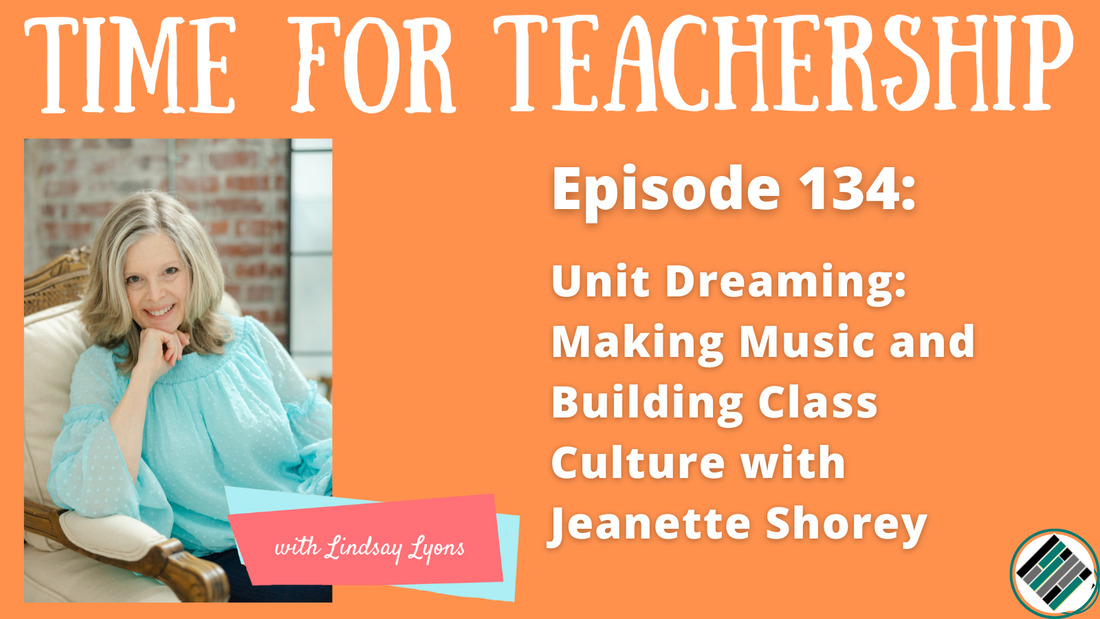
Listen to the episode by clicking the link to your preferred podcast platform below:
In this episode, Jeanette Shorey and I co-create a unit using my unit planning process. This one’s for music teachers (or any teacher wanting to incorporate music into their classroom), and would be great for the beginning of the year as the class culture is being developed.
Jeanette Shorey is National Board Certified music teacher with over 2 decades of experience teaching general music, choir, Orff ensembles, and group guitar. Jeanette is an Arts Integration Specialist, an instructional coach, a National presenter and a mentor. In this episode, we apply a step-by-step unit planning protocol to dream up a new unit where students co-create a supportive class culture and express the pursuits of identity, criticality, and joy through music! Unit Planning Step 1: Context/Spark We’re creating the first unit of the year where we develop class culture and explore, celebrate, and normalize different genres of music. The unit will take about 8 weeks, seeing students once a week for about 30-45 minutes per class. Unit Planning Step 2: Pursuits (from Dr. Muhammad’s HILL Model) Identity: How will our unit help students to learn something about themselves and/or about others? Students will see themselves as a whole person, with all of their identities affirmed. They’ll also see themselves as a person who contributes to and works positively with the class as a whole. Importantly, Jeanette wants students to feel confident in their identities as creators. This includes students feeling comfortable sharing ideas with the confidence no one will laugh at them. Criticality: How will our unit engage students’ thinking about power and equity and the disruption of oppression? Each class has a different personality and a different way of working together in addition to classes spanning multiple grades, which means addressing power, equity, and how to disrupt oppression may require different approaches unique to each group. Joy*: How will my unit enable, amplify, and spread joy? *Joy is: beauty, aesthetics, truth, ease, wonder, wellness, solutions to the problems of the world, personal fulfillment, art, music Jeanette’s goal is that students always find joy in Music class. She wants them to say, “That was my most fun class all week!” The goal is for students to cultivate a love of music, and for music class to not feel like a struggle for students. Unit Planning Step 3: Project Question What would it look like if we created music that shows how fabulous we are? Unit Planning Step 4: Summative Project (Publishing Opportunity and Possible Formats) Student music can be published as YouTube videos on the school’s private YouTube channel. The music would likely be played on non-pitched percussion instruments. (Jeanette likes ukuleles!) Unit Planning Step 5: Unit Arc Hook (2 lessons) Story book lesson: All Are Welcome Here by Alexandra Penfold. Story book lesson: Your Name is a Song by Jamila Tompkins Bigalow. In this second lesson, students can do a Circle activity with the following rounds:
Build the Base (approximately 1 lesson) Teach 4-measure rhythm. (The goal is for students to be able to create a 4-measure rhythm for any concept with lyrics and play it on any one of 4 instruments.) Case Studies Create a 4-measure rhythm on: First Case Study Lesson:
Second Case Study Lesson:
Third Case Study Lesson:
Project Work Time/ Peer Feedback (2 lessons) Students rehearse and record YouTube videos. Stay Connected You can find Jeanette on her website and on Facebook, Instagram, and YouTube @thehappymusicteacher. You can email her at jeanette@storiesthatsing.net. Her awesome podcast is The Happy Music Teacher. Books Mentioned: To help you be a happy music teacher or incorporate music in your class, Jeanette is sharing her Lesson Plan Sampler (includes a lesson plan for All are Welcome along with another storybook lesson and a fun outdoor music activity) with you for free. And, if you’re looking for more details on the ideas in this blog post, listen to episode 134 of the Time for Teachership podcast. If you’re unable to listen or you prefer to read the full episode, you can find the transcript here. Quotes:
If you enjoyed this episode, check out my YouTube channel where I compare continuum of skills to mastery based rubric:
Listen to the episode by clicking the link to your preferred podcast platform below:
In the episode, the amazing Angela Watson and I talk about how teachers can thrive alongside students, how we do best as a community of specialists, and what it looks like to be working in a flow state. If teacher retention and staff well-being is important to you, this is a must listen!
Angela Watson is a productivity and mindset specialist, author, and motivational speaker for educators. She has supported countless teachers in making teaching more effective, efficient, and enjoyable, including on her amazing podcast, Truth for Teachers, which I truly enjoy. In this episode, Angela talks to us about her vision for empowering teachers and students and creating classrooms centered on authenticity and flow. The Big Dream Angela envisions a place where educators and students can co-thrive together, with their needs not being pitted against each other. By focusing on the strengths of students and working collectively as a community, we can create an educational environment where everyone feels accepted and supported in being their authentic selves. Alignment to the 4 Stages: Mindset, Pedagogy, Assessment, and Content In order to achieve this dream, teachers can shift their mindset, adopt new pedagogical approaches, embrace innovative assessments, and ensure that content is relevant and engaging for students. Angela emphasizes the importance of empowering teachers and students to create change in their classrooms and tap into student motivation and engagement. Mindset Shifts Required Teachers do not need to be all things to all students. Instead, let’s work collectively as a community. A strengths-based approach helps staff and students! Angela says: “It's not possible to be good at everything and teaching. You cannot be a subject area expert, a developmental appropriateness, pedagogical kind of expert, explain things well, good at curriculum planning, good at parent communication, good at data entry, good at explaining yourself in IEP meetings…there's so many different things. You're going to be better at some than others, and I would love to see schools be a place where we work as a community to have all the needs met. So, instead of every individual having to be good at every single thing or, let's be real, to be excelling…What if we thought about it as a community effort? So maybe I'm really good at preparing activities and you're really good at the relationship piece with students and they feel like they can trust you and come to you…Partner together instead of trying to be all things to all students, which is just a recipe for burnout.” How do we make this happen? Work with Others Angela says, “It's much harder to dehumanize or demonize…people who don't share your values if you have accomplished something with them. If you've worked to get an extra recess break with people who have different viewpoints than you, it's much harder then, when we're talking about book banning, to be like ‘You're a monster who hates kids.’ Clearly you're not, because you just worked with me to get more recess time. So are there ways that we can work towards things that we do have in common, to create a positive change? And then, can we just find this small cadre of like minded folks to to push the envelope a little bit towards the things that are maybe not what anyone agrees on?” Pedagogically… Amplify student voice and belonging Follow students' lead and interests, allowing them to be more engaged in the learning process. Create a space for students to feel vulnerable, fostering a sense of belonging and connection. Build a toolbox of strategies to support a flow state Instead of “on task”, aim for a flow state. The state of flow (Csikszenthmihalyi) is where you're so absorbed in a task that you lose track of all time. Angela says, “It's one of the peak human experiences, and the optimal way to experience a flow state is when you're being challenged.” We can support student flow by emphasizing that we're learning alongside our students and there's no judgment around not being able to concentrate. “It's not a bad thing. It is a morally neutral thing And we don't need to load it down with all this baggage and guilt and shame….We all experience things and we're just not motivated. Challenges? It can be hard to find the time for reflection and personal growth as educators and overcome feelings of inadequacy in teaching these skills if we haven’t mastered them ourselves yet. (But we can learn alongside students!) One Step to Get Started Start by noticing and affirming the strengths and interests of your students. This simple act can have a profound impact on their engagement and motivation, ultimately contributing to a more fulfilling educational experience for both students and teachers. Stay Connected You can find Angela on her website. Also, check out her 40 Hour Teacher Workweek program and Finding Flow Solutions curriculum. To help you find the time and energy to implement some of the ideas we discussed today, Angela is sharing her and her students’ wisdom with you during The 40 Hour Teacher Workweek Online Summit! (This was free for live attendees July 10-11, but you can still access the recording for $19.) And, if you’re looking for more details on the ideas in this blog post, listen to episode 133 of the Time for Teachership podcast. If you’re unable to listen or you prefer to read the full episode, you can find the transcript here. Quotes:
If you enjoyed this episode, check out my YouTube channel where I coach teachers on addressing unplanned issues in class:
9/11/2023 132. A Framework for Teaching Structural Racism in US History with Ayo Magwood M.ScRead Now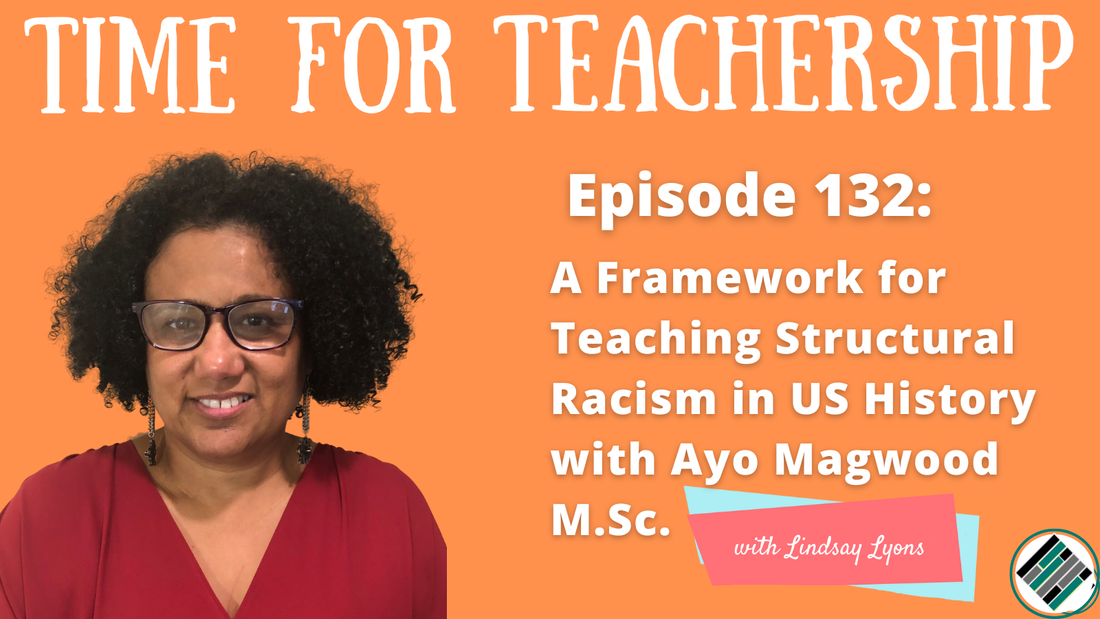
Listen to the episode by clicking the link to your preferred podcast platform below:
In this podcast episode, Ayo shares her innovative approach to teaching structural racism and fostering civic consciousness in the classroom. Discover how using data inquiries, historical context, and value tensions can empower students to think critically, engage in national conversations, and shape a better future.
Ayo Magwood, M.Sc., (Uprooting Inequity, LLC) specializes in evidence-based, apolitical, and solutionary training on understanding and remediating structural racism. She is passionate about fostering cross-difference cooperation towards realizing equal opportunity for all. Her superpower is her ability to synthesize a wide range of research, data, primary sources, and abstract concepts and weave them into engaging narratives and diagrams. Ayo was recently recognized as a leading expert on social justice education. She has a B.A. from Brown University and a M.Sc. in applied economics from Cornell University. The Big Dream To provide students with the historical context and understanding needed to engage in national conversations about structural racism and policy issues. Ayo’s Election Unit Ayo created an election unit that focused on historical context and understanding rather than candidates. Designed to equip students with the knowledge they need to engage in national conversations and shape a better future, Ayo focused on teaching historical through-lines that explain racial inequality, racial tension, racism, structural racism, income inequality, and political polarization. She encouraged students to think critically, ask questions, and discover the truth for themselves. Ayo’s Framework Ayo uses data inquiries for students to uncover the existence of structural racism on their own. By distinguishing between empirical issues and opinion/policy issues, she ensures that the classroom stays focused on the evidence while promoting civic consciousness that “benefits the common good.” This approach allows for respectful conversations in the classroom and helps students understand and take informed positions on policy issues, working together across ideological differences. Focus on structural racism over bias. Ayo says, “I feel that it's more important as a US history teacher to teach that historical context and about structural racism. They have 100 chances to learn about interpersonal race outside that classroom, but they will have very few chances to learn that history and about structural racism outside the classroom. And…that historical structural racism will set them up to learn about bias.” Framing structural racism as an empirical issue, she minimizes disruptions and parent concerns while creating a learning space where students can think critically and make evidence-based decisions. Challenges, Or Where Things Could Go Wrong Two ways classroom conversations about race are disrupted by students or parents include:
Action Steps Introduce Value Tensions Invite students to identify what’s going on underneath a political disagreement and encourage students to move away from extremes, instead asking students to position themselves on a continuum. Examples: individual rights vs. common good; civil liberties vs. national security. Data Inquiries Give students space to investigate and draw their own conclusions from empirical data. Implicit Practices Model that we all make mistakes and learn from them. Foster an “equity-conscious identity” or a “we” identity. Get Started! Read! You can start with Ayo’s Psychology Today article. Survey your students and ask for feedback on your lessons. Get Ayo’s free lesson on perspectives consciousness and start introducing values tensions in your class. Stay Connected You can find this week’s guest on her website, Uprooting Inequity. To help you introduce value tensions and perspectives consciousness in your classroom, Ayo is sharing a free lesson with you! And, if you’re looking for more details on the ideas in this blog post, listen to episode 132 of the Time for Teachership podcast. If you’re unable to listen or you prefer to read the full episode, you can find the transcript here. Quotes:
If you enjoyed this episode, check out my YouTube channel where I show you how to create an intellectual ancestors tree:
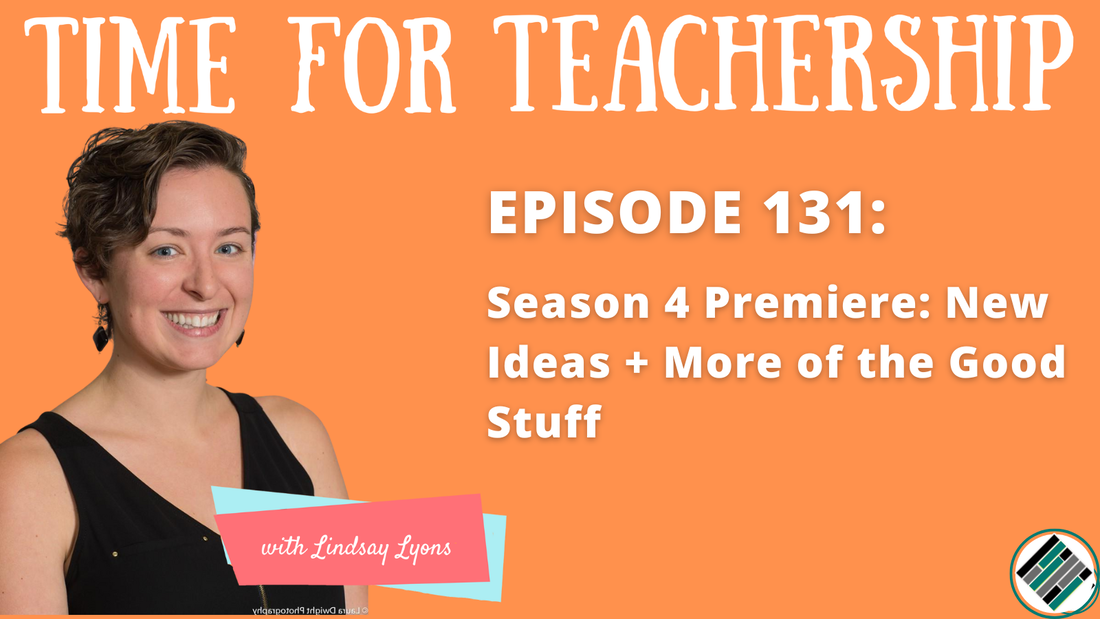
Listen to the episode by clicking the link to your preferred podcast platform below:
Wow, we’re entering the 4th season of this podcast! Each year, it has evolved to better your listening experience. I’m so excited to tell you what’s coming in the new season!
More Unit Dreaming What started as a series has generated a lot of enthusiasm from listeners and unit dreaming guests alike. Additionally, the department teams I work with for my Curriculum Boot Camp events always crave more examples of unit outlines. So, unit dreaming episodes will be a regular feature of the show. I plan to start with one per month, and we can always expand from there. For more “What does this look like in action?” support around unit planning and building, my YouTube channel has a “Unit Planning in Action” playlist dedicated to designing sample units. If 5-minute walkthrough videos of examples is your thing, check it out! If you like a good challenge, follow or connect with me on LinkedIn, where I share a #UnitDreaming spark at the start of each week. Add a comment to tell me how you would build the spark into a unit or coach a teacher to build a unit around the spark. Or use it as a private journal prompt and develop what Dr. Gholnecsar Muhammad calls “curriculum fluency.” (Here’s our episode with Dr. Muhammad.) Don’t worry about missing previously posted #UnitDreaming sparks, you can check out all of the past sparks here. More Guests Now that I have a walkthrough/mini tutorial-style YouTube channel, I would love to make more space for the brilliance of guests on the show. Many guests record 4-6 months (or more) in advance of the episode air date because there’s so many awesome people to interview. Furthermore, I have declined to interview prospective guests because of my narrow focus on curriculum design during season 3. While I will continue to focus on things that will really move the needle for you within the topics I specialize in, I also want to bring back a focus on student voice and co-creation in the realms of unit design, yes, but also on “voice” in classroom discussions as an instructional practice as well as “voice” in co-creating school policies and participating in school governance alongside adults (which is my research background). More Flexibility I also want to be less rigid in my scheduling. I used to alternate solo shows and guest episodes in an every other week cadence. This season, I want to create solo shows as I have something important to share, and not feel like I need to record a solo show just to fit the schedule I made. This may mean some months have 3 solo shows and others have none. We’ll see how it goes! I want to hear from you! What do you think of this plan? Nothing is set in stone. (See “More Flexibility.”) And ultimately, I want this podcast to be as helpful as possible to you! I know there are podcasts I listen to that I think “I want more solo shows from the host!” and others where I want more guests. So, tell me what your ideal ratio of solo:guest shows are, share the topics or questions you want to be addressed. Feel free to reply in the comments or send me an email at hello@lindsaybethlyons.com. Just so you never miss an episode…make sure you click or tap “Follow” on your favorite podcast platform. Thanks for continuing on this beautiful ride with me. Here’s to Season 4! If you’re looking for more details on the ideas in this blog post, listen to episode 131 of the Time for Teachership podcast. If you’re unable to listen or you prefer to read the full episode, you can find the transcript here.
See how you can unit plan using math and justice connections in this video:
|
Details
For transcripts of episodes (and the option to search for terms in transcripts), click here!
Time for Teachership is now a proud member of the...AuthorLindsay Lyons (she/her) is an educational justice coach who works with teachers and school leaders to inspire educational innovation for racial and gender justice, design curricula grounded in student voice, and build capacity for shared leadership. Lindsay taught in NYC public schools, holds a PhD in Leadership and Change, and is the founder of the educational blog and podcast, Time for Teachership. Archives
January 2024
Categories |
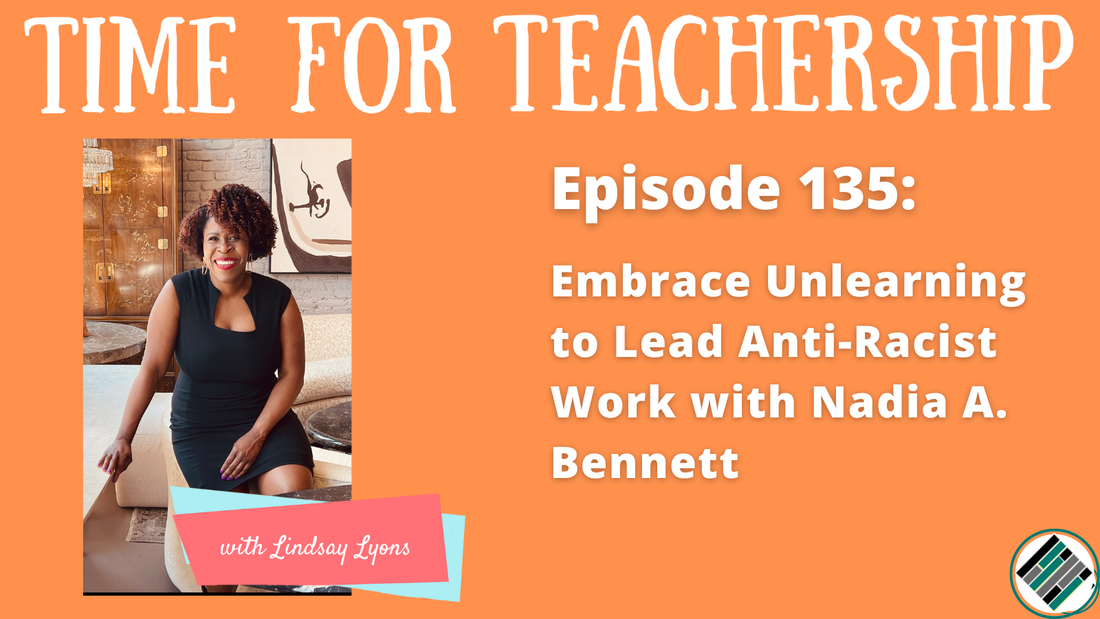
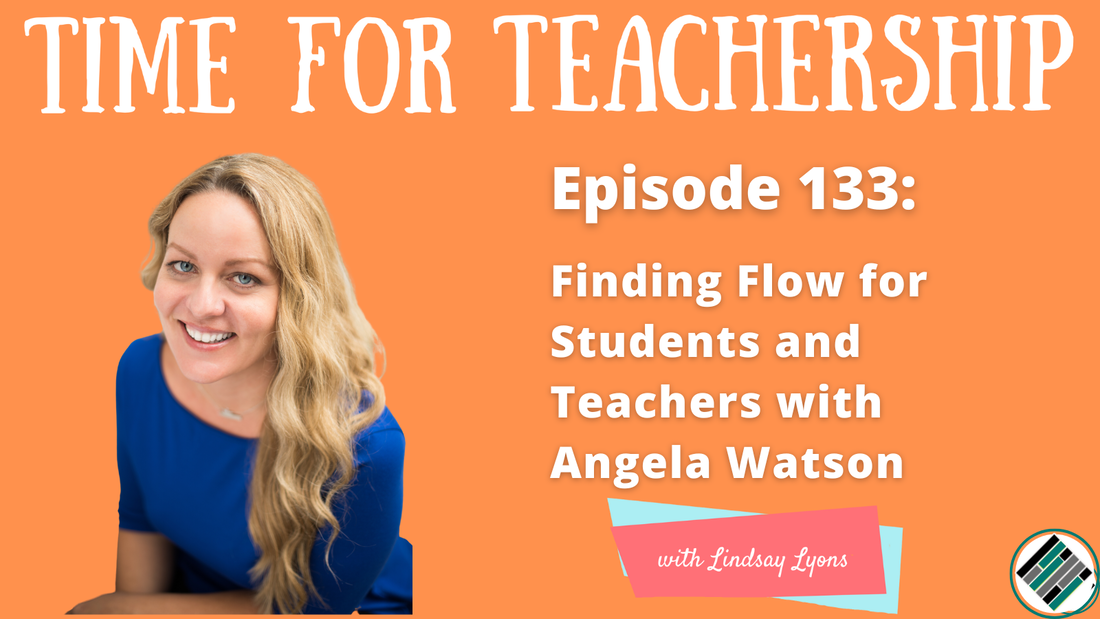
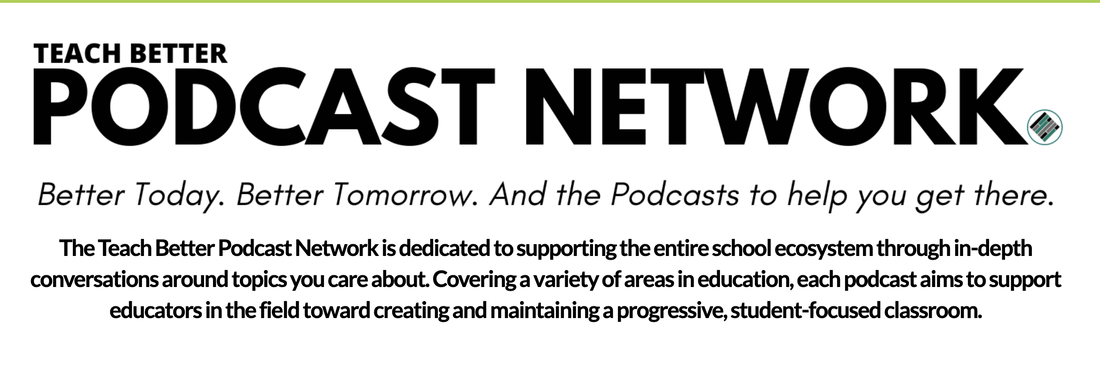
 RSS Feed
RSS Feed